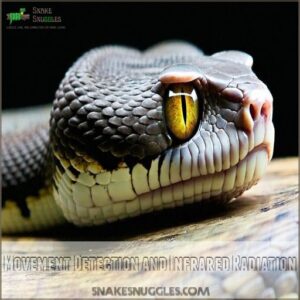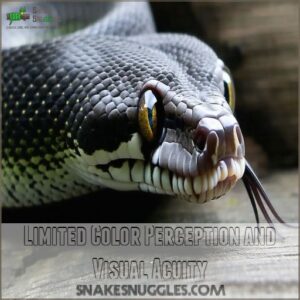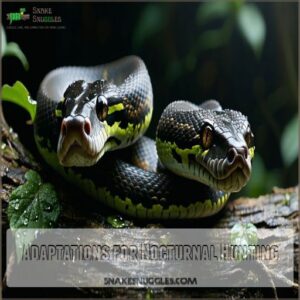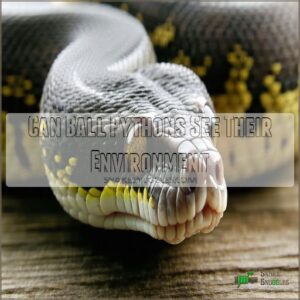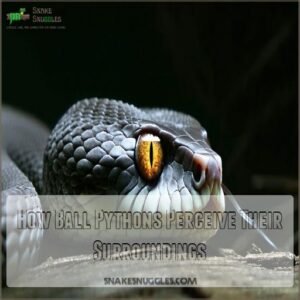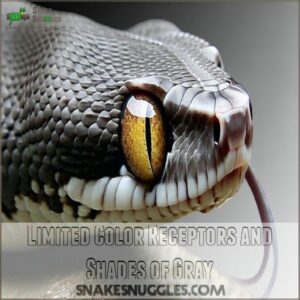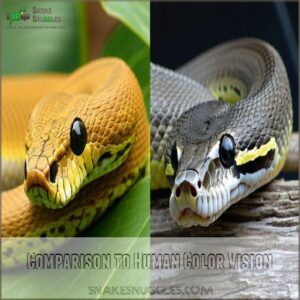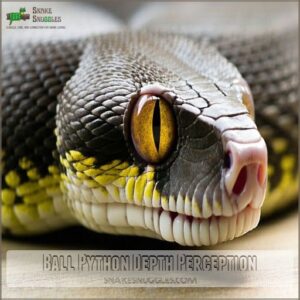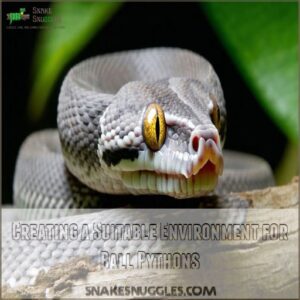This site is supported by our readers. We may earn a commission, at no cost to you, if you purchase through links.
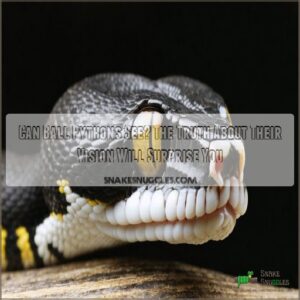
What makes these snakes truly remarkable is their sophisticated heat-sensing system – they can detect temperature differences as tiny as 0.003°C through special pits near their mouth.
Combined with their excellent sense of smell, your python relies on a fascinating trio of senses to navigate their world.
Table Of Contents
- Key Takeaways
- Ball Python Vision Capabilities
- Can Ball Pythons See Their Environment
- How Ball Pythons Perceive Their Surroundings
- Ball Python Color Vision
- Ball Python Depth Perception
- Ball Python Vision in Low-Light Conditions
- Creating a Suitable Environment for Ball Pythons
- Frequently Asked Questions (FAQs)
- Do ball pythons recognize their owners?
- Can ball pythons hear you talk?
- How do ball pythons see humans?
- What does it mean when a ball python stares at you?
- Can ball pythons see at night?
- How do ball pythons see?
- Do ball pythons have good vision?
- Do ball pythons have eye problems?
- Can ball pythons see with their eyes?
- Can python snakes see?
- Conclusion
Key Takeaways
- Your ball python’s vision is quite limited; they’re nearsighted with roughly 20/400 vision, meaning they need to be 20 feet from an object to see it as clearly as you would from 400 feet away.
- While your python can only see in shades of gray with limited blue and green perception, they excel at detecting movement from 6–9 feet away and use specialized heat-sensing pits to detect temperature differences as small as 0.003°C.
- Your snake doesn’t just rely on vision—they combine their eyesight with heat-sensing abilities and an excellent sense of smell to effectively navigate their environment and hunt prey.
- You’ll find your python sees best in low-light conditions thanks to their high concentration of rod cells, making them well-adapted for nocturnal activity despite their limited color vision.
Ball Python Vision Capabilities
You’ll find that your ball python’s vision is quite different from your own, as they’re short-sighted and see best at close range while focusing primarily on moving objects.
While their color vision is limited to just two colors, they make up for this with remarkable infrared detection abilities that help them locate prey in low light conditions.
Movement Detection and Infrared Radiation
Your ball python’s vision is like a sophisticated motion detector combined with heat-sensing technology.
This is largely due to their unique vertical slit pupils for depth perception.
When hunting, they’ll detect movement from 6-9 feet away, while their heat-sensing pits pick up infrared radiation from warm-blooded prey.
Think of it as having built-in night vision goggles with thermal imaging.
This dual system helps them navigate and hunt effectively, even in complete darkness.
Limited Color Perception and Visual Acuity
Beyond detecting movement, ball pythons have quite different color vision than we do. Think of them as seeing the world through a black-and-white TV with just two color channels. Their visual acuity sits around 20/200 to 20/400, meaning they’re legally blind by human standards.
- They can only distinguish two colors (likely blue and green)
- Visual details blur beyond a few inches
- Movement detection works from 6-9 feet away
- Colors appear mostly as shades of gray
Adaptations for Nocturnal Hunting
Ball pythons come equipped with remarkable adaptations for hunting in darkness.
Their specialized night vision system includes a high concentration of light-sensitive rod cells, allowing them to detect even subtle movements in low light.
Combined with heat-sensing pits that pick up infrared radiation from warm-blooded prey, these snakes are perfectly equipped for nocturnal hunting, making them efficient predators despite their limited color vision.
Can Ball Pythons See Their Environment
Snakes, particularly ball pythons, navigate their world through a fascinating blend of senses, with vision playing a supporting role.
You’ll find these remarkable reptiles equipped with eyes that, while not as sharp as human vision, are perfectly adapted to their lifestyle. Picture having 20/200 to 20/400 vision – that’s what your ball python experiences, making them fundamentally short-sighted.
For best vision, owners can invest in a ball python’s environment with products from ball python vision specialists, like those found at reptile eye care products.
They can spot movement from 6-9 feet away but struggle to make out fine details beyond a few inches.
While they mightn’t see the world in vivid color like we do, their eyes excel at detecting motion and changes in light intensity.
During shedding, their vision becomes temporarily impaired as the protective eye cap, called the brille, becomes cloudy before being shed along with their skin.
How Ball Pythons Perceive Their Surroundings
You’ll find that your ball python doesn’t just rely on its eyes to understand its world, as it combines vision with specialized heat-sensing pits and a remarkable sense of smell.
While these snakes can detect movement and changes in light intensity, they’re actually using a complex system of sensory tools to navigate their environment and locate prey.
Detecting Movement and Changes in Light Intensity
Regarding movement detection, your ball python’s vision resembles a highly sophisticated motion sensor.
Despite limited visual acuity, they’re remarkably sensitive to changes in light intensity and can track moving objects from 6-9 feet away.
Their low-light vision capabilities are due to a high rod cell concentration, allowing them to detect movement more effectively in dim environments, such as those described in Ball Python Vision.
Think of their eyes as specialized motion detectors – they might miss stationary objects but won’t miss that mouse scurrying across their enclosure, thanks to their rod-dominated retinas.
Use of Heat-Sensing Pits for Warm-Blooded Prey
Heat-sensing pits give your ball python an edge in hunting that’s like having night-vision goggles. These specialized organs detect infrared radiation from warm-blooded prey with remarkable accuracy. Many ball python owners even set up custom Ball Python Heat Pits to create ideal environments for their pets.
Here’s what makes these heat sensors so impressive:
- Can detect temperature differences as small as 0.003°C
- Effective up to 1 meter away
- Work perfectly in complete darkness
- Process thermal information in real-time
- Function independently of regular vision
Instead of relying solely on eyesight, your python’s heat-sensing precision turns it into a sophisticated hunting machine.
Importance of Sense of Smell in Navigation
Your ball python relies heavily on olfactory cues for navigation, using its forked tongue to collect scent particles from the air. This sophisticated chemical sensing system helps them build a detailed map of their surroundings.
| Sense | Primary Use | Detection Range |
|---|---|---|
| Smell | Navigation | Up to 20 feet |
| Tongue Flicking | Chemical Analysis | 1-3 feet |
| Vomeronasal Organ | Prey Location | 5-10 feet |
A ball python’s tongue flicks collect essential information about nearby prey, predators, and environmental features, compensating for their limited vision.
Ball Python Color Vision
You’ll find that your ball python’s color vision is quite different from your own, as these fascinating reptiles can only distinguish between two colors.
While humans can see millions of colors, your snake primarily relies on a combination of these two colors along with various shades of gray and white to navigate their world.
Limited Color Receptors and Shades of Gray
Understanding your ball python’s color vision starts with their limited color receptors. Unlike many animals, these snakes primarily see the world in shades of gray, having just two types of cone cells in their retinas.
This adaptation offers three key advantages:
- Enhanced contrast detection in low light
- Better movement tracking of prey
- Improved night vision capabilities for hunting
These grayscale specialists prove that sometimes less is more in nature’s design.
Comparison to Human Color Vision
While you see a rainbow of colors, your ball python’s world is vastly different.
Unlike humans who’ve three types of cone cells for detecting red, green, and blue, ball pythons only possess two types of color receptors.
This means they’re basically colorblind, seeing the world in limited hues – likely combinations of just two colors along with various shades of gray and white.
Impact of Color Vision on Hunting and Environment
Ball pythons navigate their world differently than you might expect.
Their limited color vision actually enhances their hunting success by focusing on what matters most – movement and heat signatures.
Like a highly specialized night-vision camera, they’ve evolved to detect subtle changes in their environment, making color vision less critical. This adaptation perfectly suits their nocturnal lifestyle and hunting strategy.
Ball Python Depth Perception
You’ll find that your ball python’s depth perception isn’t quite like yours, as they rely more on their heat-sensing pits and keen sense of smell to navigate their environment.
While they can detect movement within 6-9 feet, they’ll need their other specialized senses to accurately judge distances and locate prey.
Limited Depth Perception and Relying on Other Senses
Unlike humans who rely heavily on vision for depth perception, your ball python’s spatial awareness comes from a combination of senses working together.
When judging distances, they’re near-sighted and can struggle to determine how far away objects are.
That’s why you’ll notice them cautiously approaching things, using their other senses to build a complete picture of their environment. Ball pythons’ spatial awareness is a combination of senses.
Use of Heat-Sensing Pits and Sense of Smell
Your ball python’s incredible heat-sensing pits act like built-in thermal cameras, detecting even the slightest warmth from prey.
Think of these pits as nature’s night vision goggles, working alongside their keen sense of smell.
When your python flicks its tongue, it’s gathering chemical data about its surroundings – a behavior that perfectly complements their thermal detection abilities, making up for their depth perception limitations.
Navigating Obstacles and Locating Prey
When hunting prey, these remarkable snakes combine multiple senses to create a detailed mental map of their surroundings.
While their depth perception isn’t stellar, they’ve got a few tricks up their scales.
Heat-sensing pits detect warm-blooded prey’s thermal signature, while their flicking tongue gathers chemical cues from the environment. Together with their motion-sensitive vision, these tools help them navigate obstacles and strike with impressive accuracy. Heat-sensing pits and flicking tongue are key to their hunting success.
Ball Python Vision in Low-Light Conditions
You’ll find your ball python’s eyes work best in dim conditions, as they’ve specialized cells that help them detect movement and navigate in near darkness.
While they can’t see colors at night, their eyes contain a high concentration of light-sensitive rods.
This, combined with their ability to detect ultraviolet light, allows them to move confidently through their environment when you’re fast asleep. Their eyes are well-suited for night vision.
Night Vision and Ability to See in Low-Light Conditions
Ball pythons excel at moving through darkness, thanks to their specialized retinas packed with rod cells. These nocturnal hunters thrive in low-light conditions, though their vision isn’t exactly like night-vision goggles.
- Their retinas contain 80-90% rod cells for enhanced light sensitivity
- Vision remains sharp even in near-total darkness
- Color perception switches off at night, replaced by grayscale vision
Detection of UV Light for Navigation and Prey Location
Detecting ultraviolet light gives ball pythons a secret superpower for finding their way around and spotting prey.
This ability helps them navigate their environment with surprising precision.
Their UV sensitivity helps them create a complete picture of their surroundings. Albino ball pythons, though more sensitive to bright light overall, benefit especially from this.
Creating a Suitable Environment for Ball Pythons
You’ll need to adjust your ball python’s environment to match their unique visual capabilities, including their limited color perception and excellent motion detection abilities.
Since your snake primarily relies on heat sensing and movement to navigate their surroundings, you can create an ideal habitat by providing appropriate lighting, multiple hiding spots, and maintaining a proper day-night cycle.
Mimicking Natural Habitat and Providing Hiding Spots
Your ball python’s vision works best in a natural-feeling habitat. Just like these snakes navigate their African homes using a mix of senses, you’ll want to recreate those conditions: Incorporate custom-built enclosures (https://snakesnuggles.com/how-to-set-up-a-ball-python-cage/) to allow for customized dimensions and features that can closely mimic their natural environment.
Layer substrate 2-3 inches deep with a mix of coconut husk and forest floor bedding.
- Create temperature gradients between 75-95°F across different zones
- Position at least two snug hiding spots on both warm and cool sides
Now they can move confidently using their specialized vision and heat-sensing abilities.
Appropriate Lighting and Day/Night Cycle
Setting up proper lighting helps your ball python maintain a healthy day-night cycle.
Since these snakes have specialized vision adapted to low light, it’s essential to provide appropriate illumination throughout their habitat.
| Time | Lighting Type | Intensity |
|---|---|---|
| Morning | UVB/Daylight | Low-Medium |
| Afternoon | Mixed Light | Medium |
| Evening | Dim Light | Low |
| Night | No Light | None |
Remember to shift lighting gradually, mimicking natural dawn and dusk patterns.
Varied Diet and Catering to Unique Visual Abilities
While proper lighting sets the stage, a varied diet amplifies your ball python’s hunting prowess.
Their unique vision capabilities shape how they interact with prey, so consider these feeding strategies:
- Offer prey at dusk when their vision is most acute
- Present food items with slight movement to trigger their motion detection
- Maintain consistent feeding spots to help them rely on familiar visual cues
Remember, they’re using heat pits and scent alongside vision to hunt successfully.
Frequently Asked Questions (FAQs)
Do ball pythons recognize their owners?
Ball pythons can’t visually recognize their owners since they’ve limited vision and color perception.
However, they may become familiar with your scent and handling patterns through their strong sense of smell.
Can ball pythons hear you talk?
Like feeling vibrations at a concert, your ball python senses sound through vibrations, not your actual voice.
They’ll pick up your movements and ground vibrations, but they don’t have traditional ears like humans do.
How do ball pythons see humans?
Your ball python sees you as a blurry, moving shape rather than a detailed figure.
They’ll rely on their heat-sensing pits to detect your warmth and their tongue to gather chemical information about you.
What does it mean when a ball python stares at you?
Similar to a curious child exploring their world, when a ball python stares at you, they’re not actually focused on you.
They’re detecting movement and heat patterns.
While judging their environment for safety.
Can ball pythons see at night?
Ball pythons see well at night, relying on specialized rod cells in their retinas for movement detection.
They can’t perceive colors in darkness but effectively track prey using their remarkable heat-sensing abilities.
How do ball pythons see?
With eyes adapted to detect movement up to 9 feet away.
Your python’s vision combines a unique set of tools: limited color perception (mostly grays), heat-sensing pits, and specialized night vision for hunting.
Do ball pythons have good vision?
Your snake’s vision isn’t great compared to yours. They’re short-sighted with limited color perception, seeing best at close range.
However, they make up for it with excellent heat-sensing abilities and motion detection.
Do ball pythons have eye problems?
Reptilian eyes can experience several common issues like retained eye caps during shedding, infections, and injuries.
You’ll need to monitor your ball python’s eyes regularly and maintain proper humidity to prevent most problems.
Can ball pythons see with their eyes?
Ball pythons can see through their eyes, but they’re short-sighted and mainly focus on movement.
They’ll see you best from a few inches away.
They use heat-sensing pits to detect warm-blooded prey.
Can python snakes see?
Python snakes can see, but they’re short-sighted and rely heavily on other senses. They’ll spot movement within 6-9 feet and use heat-sensing pits to detect warm-blooded prey in darkness.
Conclusion
Like a skilled hunter using multiple tools, your ball python navigates their world through an intricate web of senses.
While they can see, their vision differs substantially from ours.
They rely on their remarkable heat-sensing abilities, keen movement detection, and extraordinary sense of smell to thrive.
Understanding these unique capabilities helps you create an environment that caters to their natural instincts, ensuring they live their best life as your scaly companion.

